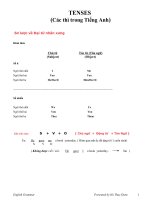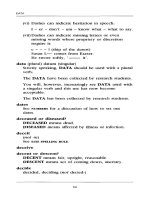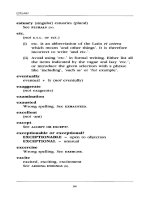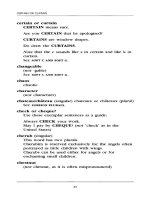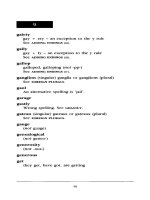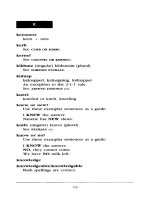Verb and subject agreement in English
Bạn đang xem bản rút gọn của tài liệu. Xem và tải ngay bản đầy đủ của tài liệu tại đây (402.22 KB, 54 trang )
BỘ GIÁO DỤC VÀ ĐÀO TẠO
TRƯỜNG ĐẠI HỌC DÂN LẬP HẢI PHÒNG
ISO 9001 : 2008
KHÓA LUẬN TỐT NGHIỆP
NGÀNH: NGOẠI NGỮ
HẢI PHÒNG - 2009
HAIPHONG PRIVATE UNIVESITY
FOREIGN LANGUAGES DEPARTMENT
GRADUATION PAFER
A study on subject – verb agreement
By:
Phạm Vân Anh
Class:
NA902
Supervisor:
Trần Thị Ngọc Liên
HAI PHONG - 2009
BỘ GIÁO DỤC VÀ ĐÀO TẠO
TRƯỜNG ĐẠI HỌC DÂN LẬP HẢI PHÒNG
Nhiệm vụ đề tài tốt nghiệp
Sinh viên: Mã số:
Lớp: Ngành:
Tên đề tài:
Nhiệm vụ đề tài
1. Nội dung và các yêu cầu cần giải quyết trong nhiệm vụ đề tài tốt nghiệp
( về lý luận, thực tiễn, các số liệu cần tính toán và các bản vẽ).
……………………………………………………………………………
……………………………………………………………………………
……………………………………………………………………………
……………………………………………………………………………
……………………………………………………………………………
……………………………………………………………………………
……………………………………………………………………………
……………………………………………………………………………
2. Các số liệu cần thiết để thiết kế, tính toán.
……………………………………………………………………………
……………………………………………………………………………
……………………………………………………………………………
……………………………………………………………………………
……………………………………………………………………………
……………………………………………………………………………
……………………………………………………………………………
……………………………………………………………………………
……………………………………………………………………………
3. Địa điểm thực tập tốt nghiệp.
……………………………………………………………………………
……………………………………………………………………………
……………………………………………………………………………
CÁN BỘ HƯỚNG DẪN ĐỀ TÀI
Người hướng dẫn thứ nhất:
Họ và tên:
Học hàm, học vị:
Cơ quan công tác:
Nội dung hướng dẫn:
Người hướng dẫn thứ hai:
Họ và tên:
Học hàm, học vị:
Cơ quan công tác:
Nội dung hướng dẫn:
Đề tài tốt nghiệp được giao ngày tháng năm 200
Yêu cầu phải hoàn thành xong trước ngày tháng năm 200
Đã nhận nhiệm vụ ĐTTN Đã giao nhiệm vụ ĐTTN
Sinh viên Người hướng dẫn
Hải Phòng, ngày tháng năm 200
HIỆU TRƯỞNG
GS.TS.NGƯT Trần Hữu Nghị
PHẦN NHẬN XÉT TÓM TẮT CỦA CÁN BỘ HƯỚNG DẪN
1. Tinh thần thái độ của sinh viên trong quá trình làm đề tài tốt nghiệp:
……………………………………………………………………………
……………………………………………………………………………
……………………………………………………………………………
……………………………………………………………………………
……………………………………………………………………………
……………………………………………………………………………
……………………………………………………………………………
……………………………………………………………………………
2. Đánh giá chất lượng của khóa luận (so với nội dung yêu cầu đã đề ra trong
nhiệm vụ Đ.T. T.N trên các mặt lý luận, thực tiễn, tính toán số liệu…):
……………………………………………………………………………
……………………………………………………………………………
……………………………………………………………………………
……………………………………………………………………………
……………………………………………………………………………
……………………………………………………………………………
……………………………………………………………………………
……………………………………………………………………………
……………………………………………………………………………
3. Cho điểm của cán bộ hướng dẫn (ghi bằng cả số và chữ):
……………………………………………………………………………
……………………………………………………………………………
……………………………………………………………………………
Hải Phòng, ngày … tháng … năm 2009
Cán bộ hướng dẫn
(họ tên và chữ ký)
NHẬN XÉT ĐÁNH GIÁ
CỦA NGƯỜI CHẤM PHẢN BIỆN ĐỀ TÀI TỐT NGHIỆP
1. Đánh giá chất lượng đề tài tốt nghiệp về các mặt thu thập và phân tích tài liệu,
số liệu ban đầu, giá trị lí luận và thực tiễn của đề tài.
2. Cho điểm của người chấm phản biện :
(Điểm ghi bằng số và chữ)
Ngày tháng năm 2009
Người chấm phản biện
Acknowledgements
In the process of implementing this graduation paper, I have to face to many difficulties. But
thanks to the help and guidance of many people, I overcame all troubles and completed my
graduation paper.
First of all, I do want to express may grateful thanks to Mrs Tran Thi Ngoc Lien – my supervisor
for her encouragement and guidance. During my study process, she has willingly and readily
suggested and given me valuable advice and detail comments about my study.
Furthermore, never can I forget the help and enthusiastic guidance of teachers in foreign
language department. It’s them that have led me through lectures during four year. Thank to that
knowledge background, I could select this topic and fulfill my study.
Last but not least, I am really grateful to may family and friends for their serious support and
encouragement.
Hai phong, June 2009
Pham Van Anh
Symbol and abbreviation
S Subject
V Verb
O Object
Od Direct object
Oi Indirect object
A Adverbial
C Complement
E.x Example
Table of contents
Acknowledgement
Symbols and abbreviation
Part I : Introduction
1. Rationale 1
2. Aim of the study 1
3. Scope of the study 2
4. Method of the study 2
5. Design of the study 3
Part 2: Development
Chapter 1: theoretical background 4
I. English sentence 4
1. Definition of English sentence .4
2. Kinds of sentence 5
2.1 Traditional division 5
2.2 Quirk’s division 6
3. Sentence element 7
3.1 Subject 7
3.2 Verb 8
3.4 Complement 8
3.5 Adverbial 9
II Subject 10
1 Definition 10
2. Part of speech function as subject 11
III. Verb 12
1. Definition 12
2. Classification 12
IV. Agreement 13
1. Definition 13
2. Kind of agreement 13
Chapter 2: Subject – verb Agreement 15
I. Noun 15
1. Single noun 15
1.1 Basic single noun 15
1.2 Collective noun 18
2. Coordinated in form of noun 18
2.1 Coordination with “and”, “both and” 18
2.2 Coordination with “or”, “either or”, “neither nor”,
“not only but also” 19
2.3 Coordination with “as well as”, “along with”, “rather than”,
“together with” 19
3. Noun as an expression of quantity .20
3.1 Noun expressing number 20
3.2 Noun expressing fraction and percentage 21
4. Denominal subject .22
4.1 Nominal clause 22
4.2 Non-finite clause .22
II. Pronoun 23
1. Personal pronoun 23
2. Relative pronoun. .26
3. Indefinite pronoun 28
Chapter 3: Problems possibly encountered by non – native learners
When dealing with subject – verb agreement 32
I. Problems possibly encountered by non – native learners 32
1. Subject – related errors. 32
1.1. Errors caused by plural form of head noun 32
1.2. Errors caused by words coming between nouns and verbs 32
2 Confusion over singular and plural 33
2.1. Because of cardinal number 33
2.2. Because of contextual meaning and coordinators 34
2.3. Because of antecedent replaced by relative pronouns 35
2.4. Because of each structure’s requirement 35
3. Irregularities 36
3.1. Fields of study that end in “-ics ” .36
3.2. Certain illness that ends in “-s” .37
3.3. Name of the games ending in “s”. . 38
3.4. Plural form of collective nouns 38
3.5. Existential sentence 39
3.6. “The + adj” as noun phrase 39
3.7. Title of works, company names 40
3.8. Foreign nouns .40
3.8.1 Nouns ending in “us”, “es” is added or “us” is changed into “i”41
3.8.2 Nouns ending in “um”, “s” is added or “um” is changed into
“a” 42
3.8.3 Nouns ending in “is”, “is” is change into “es” .43
3.8.4 Nouns ending in “on”, “subject” is added or “on” is changed
into “a” 43
II Sugessions to overcome problems 43
Part 3: Conclusion 45
Reference 46
Appendix. .47
Part I : Introduction
1. Rationale
Language is an essential means of communication. Without language, people are unable to
express their thoughts, their ideals, and inform to others. Moreover, English becomes the most
popular language all over the world. Day by day, English express its role in society, and in
tightening relations between people in global.
In order to be a master of English, we need a good background of grammar. Actually, I approach
English since I was at my junior secondary school. There were certainly a variety of grammatical
structures to be fully grasped before we would like to use English effectively. At that time, the
major difficulty facing me in particular and all pupils in general was how to conjugate verb
correctly. We confused to make subject and verb agreement because of various types of subject
and other irregular rules. This reason urges me to study this theme : subject – verb agreement.
I hope that my study will help all students and pupils deal this problem easily and fell that
English grammar is no longer difficult.
2. Aims of the study
Any research all have their own purposes. Anyone who studies any fields all aims at certain
achievements. As many other students, this research also have certain aims, that is:
- Systemizing subject – verb agreement to have a research on this matter as full as
possible, from then helping particularly new beginners to study this more easily and
successfully;
- Giving problems and irregularities when dealing with topic : subject – verb agreement;
- Suggesting certain effective solutions to deal with the problems caused by subject-verb
agreement
3. Scope of the study
Agreement, or in other word, concord in English is a very wide theme. Beside subject – verb
agreement, there are concords between sentence elements like subject – subject complement
concord, object – object complement concord, etc. However, due to the limitation of time and
ability, in this research proposal, I just study the subject – verb agreement and learner’s problems
when dealing with this theme.
4. Methods of the study
To achieve the above mentioned aims, the researcher has combined different research methods in
her study.
First, data corpus are collected from different reliable sources such as books, authorized
websites. The data are mainly about the cases when subject and verb concord is presented and
performex.
Second, statistic analysis is used via survey questionnaires and informal interview in order to
find out the common problems often encountered by non-native learners regarding subject-verb
agreement.
Further more, analysis are made into irregularities which often hinder the learners in the
approach to subject-verb agreement.
Finally, experimental analysis method is made use. During class hours, examples or cases of
subject-verb concord is shown as compulsory exercise so that the students can work on them,
which help to figure out what common problems they may face and how they can deal with the
problems.
5. Design of the study
A table of contents with page numbers in which they are presented will help the readers have a
clear overview of the research proposal. It also helps readers to find the part they need more
easily and quickly.
Part I namely “Introduction” consists of rationale of the study, aims of the study, scope of the
study, method of the study, and the design of the study.
Part II called “Development” contains three chapters:
Chapter 1, the theoretical background, deals with definition of English sentence, sentence
elements, subject and verb.
Chapter 2 is the main part which analyses types of subject affecting to subject – verb
agreement.
Chapter 3 shows a lot of learner’s problems and irregularities when dealing with this theme
Part IIIt is “conclusion” which restates all the presented information
Part II: Development
Chapter one: Theoretical background
I. English sentence
1. Definition of English sentence
You have used sentences all your life to communicate ideas. However, you may not have paid
close attention to how sentences are correctly and effectively written. There are different ways to
define a sentence but we’d prefer a traditional grammar – based definition: “sentence is the
largest meaningful unit of grammar, consisting of a subject and a predicate.
The subject answers the question “who/ what” is sentence about? And the predicate answers the
question what does the sentence say about? The order of the sentence vary according to types of
sentence (statement, question, request, etc)
A sentence conveys a complete meaning or idea serving a definite purpose of communication.
[1] David looks intelligent
(Stating an opinion)
[2] My bicycle has broken down
(Stating a fact)
[3] Do you know that man?
(Asking a question)
[4] Can you help me?
(Asking a favor)
[Nguyen Van An, 2003:636]
According to Oxford Advanced learner’s dictionary, sentence is “the highest unit of grammar,
usually containing a subject, an object, a verb, etc, and expressing a statement, question, or
command”. For example:
[5] It is raining tomorrow
[6] Many scientists believe there is a major earthquake in California in the next few years
[7] What place have you been to since you came to this city
[8] Put it in the desk
[9] Let me show you a way to escape
[AS Hornby, 1948:1715]
2. Kinds of sentence.
2.1 Traditional division
In many traditional grammars, three major sentence types are distinguished:
- Simple sentence: a simple sentence is one independent clause
[10] I enjoy playing tennis with my friend every weekend.
[11] I enjoy playing tennis and looking forward to it every weekend.
[Tran Thi Ngoc Lien, 2003: 7]
Notice that the second sentence has two verbs, but this is called compound verb not compound
sentence.
- Compound sentence: compound sentence is two or more independent clause joined together.
Each clause is of equal important and could stand alone. There are three ways to join
independent clauses to form a compound sentence.
+ With a coordinator:
[12] I enjoy playing football, but I hate playing baseball.
[Tran Thi Ngoc Lien, 2003: 8]
[13] I enjoy playing football, however, I hate playing baseball
[Tran Thi Ngoc Lien, 2003: 8]
+ With a semicolon:
[14] I enjoy playing football; I have playing football.
[Tran Thi Ngoc Lien, 2003: 8]
- Complex sentence: contain one independent clause and one dependent clause. In complex
sentence, one ideal is generally important than the other one. The more important idea is placed
in the independent clause, the less important idea in the dependent one. For example:
[15] Although women could own property, they could not vote.
[16] Women could not vote although they could own property.
[17] Men who are not married are called bachelors.
[18] Scientists believe that the earth’s temperature is rising.
[Tran Thi Ngoc Lien, 2003: 8]
- Compound – complex sentence: is a combination of two or more independent clauses and one
or more dependent clause. For example:
[19] After I graduated from high school, I wanted to get a good job, but I couldn’t
[20] Although women could own property, they could neither vote nor be elected to public house
[21] While I was strolling along the riverside, the murmuring of the running water comforted my
broken heart, and the whispering of the idle winds cooled my frustrated soul.
[Tran Thi Ngoc Lien, 2003: 8]
2.2 Quirk’s division
Quirk (1994) divides sentences by referring to possible arrangements of the sentence element.
There are 7 types of sentence:
- SV
[22] She is crying
- SVA
[23] She is upstairs
- SVO
[24] She is learning English
- SVOO
[25] She gave me a book
- SVOC
[26] She makes me cry
- SVOA
[27] She laid the book on the shelf.
- SVC
[28] She is a teacher
[Quirk, 1994:28]
3 Sentence elements
According to Quirk, 1994:29, element is usually a small amount of something, thus, sentence
element is a small amount of sentence. A sentence may alternatively be seen as comprising 5
units called elements of sentence. Structure: Subject, verb, complement, object and adverbial,
which are abreviated as S, V, O, C, A.
[29] I am a teacher
S V C
[30] John does exercise carefully
S V A
[31] The girl is now a student at large university.
S V A C A
[32] He had given the girl an apple
S V O
[33] His brother grew happier gradually
S V A
[34] It rained continually all day
S V A
[Quik, 1994:29]
3.1 Subject
Subject is a part of the sentence that performs an action or which is associated with the action.
[35] He causes the motor accident.
Subject is what (or whom) the sentence is about, while the predicate tell something about
subject.
To determine the subject of sentence, first isolate the verb and make a question by placing “who”
or “what” before it. The answer is subject.
Every subject is built around one noun or pronoun (or more), when stripped of all the worlds that
modify it, is known as the simple subject.
Ex: a piece of pepperoni pizza would satisfy his hunger
The subject is build around the noun: “piece”
3.2 Verb
Verb also is a part of the sentence causes the action. This is called the main verb.
[36] A dog bits the children
The main verb may be stand alone of may be preceded by auxiliary verb which determine the
mood, tense, voice, or aspect of the verb.
3.3 Object
Object is a noun, noun phrase or noun clause which refer to a person thing, etc affected by the
action of a verb, or which depends on a preposition.
[37] He took the money
Od
[38] He took what he wanted
Od
[39] I gave him money
Oi
[40] I received money from her
Prepositional Object
[Quik, 1994:41]
It should be understood that Od is by far the more frequent kind of object and what with most
ditransitive verb (verb that require two object: one is Od, one is Oi). It must always be present if
there is an Oi in the sentence. The Oi almost always preceded by the Od. For example:
[41] He had given a child an apple
Oi Od
[Quik, 1994:41]
In fact, we only need to distinguish two types of object: direct and indirect object. Prepositional
object is only the replacement of the indirect object by a preposition phrase. It’s when SVOO
sentence are transformed into SVOA sentence for the indirect object preceding it. For examples:
[42] She sent him a card [42a] She sent a card to him
[43] I left my friend the address [43a] I left my address for my friend.
[Quik, 1994:41]
“To” and “for” in their recipient sense, are the prepositions chiefly involved.
3.4 Complement
Complement are words, especially adjectives and nouns, used after linking verb such as be,
become describing the subject of the verb. Complements are divided into subject complement
(Cs), object complement (Co).
For example:
[44] Something must be wrong.
Cs
[45] Two bulldozers have been knocking the place flat.
Co
[Quik, 1994:45]
Subject complement has a straight forward relation to subject of sentence.
Object complement has similar relation to direct object (which the follows as the subject
complement has to a subject).
3.5 Adverbial
Adverbial is of, like or containing an adverb which is a word that adds more information about
place, time, circunstance, manner, cause, degree, etc to a verb and adjective, a phrase or another
verb. For example:
[46] Somehow he got his friends done it for him
[47] My cousin’s jokes always make me laugh
[48] He got some of kids in the neighborhood cleared out his garage
[Quik, 1994:49]
II. Subject
1. Definition
The subject is identified syntactically by the feature of position, concord, and reflection in tag
question. Semantically, all most participant roles can be associated with the subject. It can be
realized by a wide variety of group and clauses.
According to Oxford advance learner’s dictionary, subject is word(s) in a sentence naming who
or what does or undergoes the action stated by the verb, or words in a sentence about which
something is stated.
[49] I am keeping most of my money in the bank.
[50] They are placing the blame on us.
[51] The kettle is now on the store.
[AS Hornby, 1948:R42]
As the comprehensive grammar of the English language stated, the subject is often describe as
the constituent defining the topic of the sentence that which the sentence is about and which it
presupposes as its point of departure. Contrary to above definition, which is more about
syntactic, this one is more about semantic part of the sentence.
2 Part of speech become subject
Subject can be express by a variety of groups and clauses but it’s usually a noun or pronoun.
Besides, we have quantifier with noun and pronoun, without noun and pronoun, noun clause.
- Noun
[52] Jonathan loves chocolates
[53] Crocodiles are very dangerous
[Micheal swan-Catherine walter, 2000:25]
- Pronoun
[54] They went to sleep at 9:00
[55] Is anybody home?
[Micheal swan-Catherine walter , 2000:25]
- Quantifier with noun, pronoun
[56] Some of the pie was gone
[57] Both of them are nice
[Micheal swan-Catherine walter , 2000:25]
- Quantifier without noun, pronoun
[58] Some are here. Some is not
[59] Both are correct
[Micheal swan-Catherine walter , 2000:25]
- Noun clause
[60] What you say is not important
[61] How do you do it is up to you
[Micheal swan-Catherine walter , 2000:26]
III Verb
1. Definition
Verb is word or phrase indicating an action, and event, or a state or condition of subject.
Every sentence must have a verb as the verb is the heart of a sentence. Small changes in its forms
reflect many differences in meaning. One variable is number, a verb can either singular or plural.
For example:
[62] I am happy to be here
(Singular)
[63] We are not so sure about the date
(Plural)
[64] Jill loves chocolate chip cookies
(Singular)
[65] Mother and father love to go sailing
(Plural)
[66] The baby has a cold
(Singular)
[AS Hornby, 1948:R36]
The function of verb element in English clause structure is realized by the verb phrase, which
consists of one or more verb constituents.
[67] She left yesterday
[68] Did she leave yesterday?
[69] She will comeback tomorrow
[AS Hornby, 1948:R36]
2. Classification
Verb, as class of word, can be divided into three major categories, according to their function
within verb phrase, we distinguish the open class of lexical verb, auxiliary verb.
- Lexical verb are verbs denote state or action
[70] He eats icecream everyday
- Auxiliary verb is those help complete meaning of the verb phrase. It contains primary verb and
modal verb.
+ Primary verb: Do (does, don’t, doesn’t)
Have (has, haven’t, hasn’t)
Be (am, is, are, isn't, aren't)
+ Modal verb: can, could, may, might, must, will, shall, should, would, ought to, etc.
[71] He has already finished his work
[72] I am a teacher.
[73] When he called, she was watching television
[AS Hornby, 1948:R36]
IV Agreement
1. Definition
Agreement or concord can be defined as the relationship between two grammartical units such
that one of them displays a particular feature that accords with displayed( or semantically
implicit). For example:
[74] I know what is on your hand
[75] Economic has become increasingly popular course at university
2. Kinds of agreement
- Subject – verb concord: it is the concord between subject and verb in sentence.
- Subject – object concord: it is the concord between subject and object in number, person, and
gender when object is reflexive pronoun. For example:
[76] He injured himself in the left
[77] You should give yourself another chance
[
- Subject – subject complement and object – object complement
Between subject and subject complement; and between direct object and object complement
there is usually concord of number. When subject is singular, subject complement must
therefore, be singular and vice versa. For example:
[78] My child is an angle
[79] My children are angles
It is the same with object – object complement. For example:
[80] I consider my child an angle
[81] I consider my children angles
[
Chapter two: Subject – verb Agreement
I. Noun
1. Single noun
1.1 Basic single noun
Noun and verb are the basic parts of a sentence, the two teammates upon whom all others
depend. They need to agree on one major thing: number.
When a word refers to one person, place, thing, or idea, it is singular in number. When it refers
to more than one, it is plural.
Ex: Singular: Book, woman, fox.
Plural : Book, women, foxes.
The sentences do make sense when the verbs agree with their nouns in number:
[82] John and Mary is a couple.
[83] John is a real estate dealer who makes over $67,000.
[84] Mary is a farmer; she has a little lamb farm and gets a good deduction from the government,
so her family doesn't get fleeced on their taxes.
[Nguyen Van An, 2003:29]
These are the basic practices for basic single noun - verb concord:
Rule1: The number of the noun (singular or plural) determines the form of the verb, since verbs
must agree with their nouns.
[85] Some readers consider Kohlberg's theory of moral development problematic because he
only examines ways of thinking and not how emotions and gender socialization affect moral
development.
[86] Carol Gilligan, in her book entitled In a Different Voice, challenges the premise of
Kohlberg's theory.
[
Rule2: There may be more than one noun-verb pair in a sentence; you need to make sure that
each noun-verb pair agrees in number.



